For the future of fishing
Fishing: A tough tradition
Fishing has always been a dangerous job carried out in harsh conditions. But now there are additional challenges: The growing demand for fish has to be met with more sustainable methods.
This has led to international arrangements, strict fishing quotas, and attempts to manage fisheries scientifically. A hard job has become more complex, demanding flexible new fishing methods and equipment.
Modern fishing vessels require modern, robust technologies that can withstand extreme weather and uninterrupted operation. Failure is not an option. Fishing vessels typically operate in environmentally sensitive areas, so emission requirements will continue to be important. The growth of fish farming also depends on clean yet efficient vessels.
Our engines and systems have always proven to be up to the job. We develop our new technologies for high dynamic performance and well-balanced operating behavior while keeping down operating expenses (OPEX), capital expenditure (CAPEX), and specific fuel oil consumption (SFOC). The result is not just forward-looking, but efficient and reliable.
Robust systems for complex conditions: Four-stroke engines for fishing vessels
Trawlers
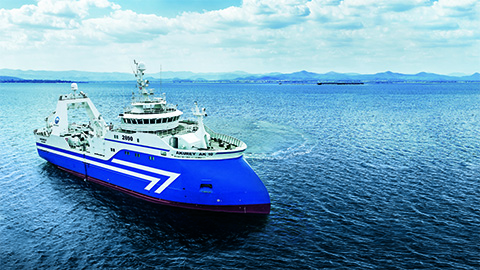
Trawlers catch fish by towing large nets, usually along the seabed (bottom trawling). Vessel sizes range from smaller fresh fish trawlers to large factory and freezer ships on which the caught fish are processed and frozen.
Towing and hauling power
Trawlers need strong engines to tow their nets, plus more power for their trawl hauling gear and refrigerating equipment. Deep-sea trawlers need even stronger engines to tow the trawls at the right depth and speed.
Operating for long periods without interruption (24/7), trawlers spend weeks or even months at sea until their holds are full. Our propulsion engines and generators are designed to be robust and compact while delivering high output flexibility without pause.
Go to Four-Stroke propulsion engines
Go to Four-Stroke diesel-electric propulsionGo to Four-Stroke auxiliary GenSets
Pelagic trawlers
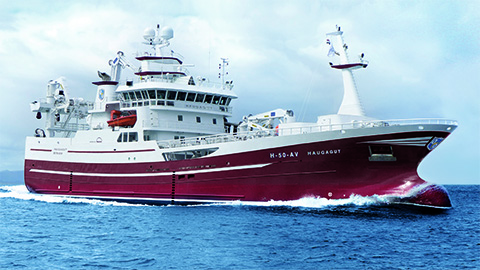
Pelagic, or mid-water trawling, is the business of catching the fish (such as herring or mackerel) that live at various levels between the seabed and the surface. Pelagic trawlers use a wide range of advanced technologies to locate, catch, and store fish in refrigerated seawater (RSW) or process and freeze the fish.
Complex power needs
Pelagic trawlers often operate over longer distances than bottom trawlers. They have to withstand harsh weather conditions and comply with strict environmental regulations. Operating costs have to be kept low.
In addition, minimizing noise levels is important for crew comfort. Vessels with such varied demands require highly reliable engines with a robust and compact design. They need power and operational flexibility for propulsion, for the winches, fish pumps, and RSW systems as well as for processing and freezing.
Go to Four-Stroke propulsion engines
Go to Four-Stroke diesel-electric propulsion
Go to Four-Stroke auxiliary GenSets
Live fish carriers
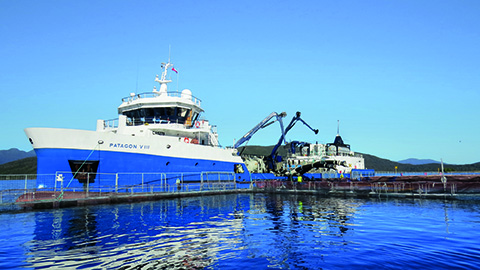
The live fish carrier, or well boat, is a relatively new type of vessel, the demand for which is steadily growing. It is used to carry smolt (young fish) to the offshore farms and to carry live fish (usually salmon) from the farms to the factories. The vessels have a multitude of important functions, including treating diseases and sorting by size, and refrigeration. And the better they do it, the better the salmon.
Gentle factories
The aquaculture industry requires efficient vessels with specialized functions such as carrying equipment for gentle handling of fish. The focus is on fish welfare, hygiene, and quality. Live fish carriers may cover large areas with many different farms. The work includes a lot of dynamic positioning. Operation should be silent and OPEX low.
A fish carrier’s engines must be reliable, robust and compact, with low noise and vibration emissions. Suitable power must be combined with operational flexibility, low SFOC and good performance at low load and high load. Low maintenance and repair requirements are also a must.
Go to Four-Stroke propulsion engines
Tuna purse seiners
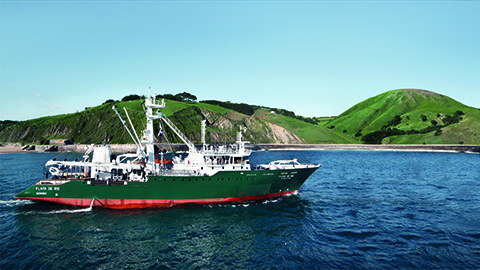
Tuna is one of the world’s favorite fish, making it a very important commercial catch. Millions of tons are consumed per year, and about 60 percent of which is caught in purse seiners. Tuna purse seiners search for, catch, and deliver tuna back to shore.
Streamlined for strength and speed
Tuna purse seiners have to cover long distances on their search for tuna, even with the help of advanced technologies. When the vessel is full, they have to return to the onshore factory at high speed. Optimizing operating and maintenance costs and reducing vessels’ environmental impact are key challenges.
The engines face heavy-duty operation in both propulsion and auxiliary tasks, so they need reliable power availability, high output, flexibility, and good partial-load performance. Keeping fuel costs low is essential.
Go to Four-Stroke propulsion engines
Hybrid marine solutions
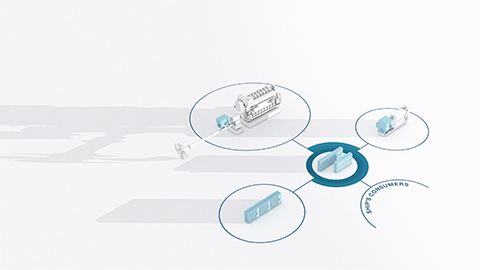
The fishing industry is facing the major challenge of complying with strict environmental standards without sacrificing propulsion efficiency and ship performance. A hybrid propulsion system is often the best solution on vessels with flexible operational profiles and running hours with both high and low power demands.
MAN HyProp ECO
MAN HyProp ECO propulsion combines the CP propeller, the diesel engine and the electric shaft machine (alternator/motor). The system overcomes the constraint on constant speed propulsion machinery by utilizing variable speed drive (VSD) technology at the shaft generator/motor. This means that the power take-off/power take-in (PTO/PTI) operates with variable propeller speed, and optimal utilization of the diesel engine is thereby achieved, which is not possible in a conventional PTO/PTI installation with constant propeller speed.
Battery power
MAN battery-hybrid systems use batteries as an additional, independent source of power for propulsion and hotel loads. Combining combustion engines and battery power onboard a vessel optimizes engine operation and loading, resulting in higher efficiency of the complete power train. A battery-hybrid propulsion solution reduces fuel consumption, exhaust emissions, and noise. At the same time, it increases the reliability of the complete power train as well as its performance due to its faster system reaction times.
MAN PrimeServ protects your energy assets from day one
Whether you feed energy into the grid or satisfy a localized demand, on land or at sea, our technicians provide what you need – where and when you need it, ensuring the availability, flexibility, and profitability of your plant.
How you benefit:
- Fast, reliable and expert customer support
- Prompt delivery of OEM spare parts
- Bespoke O&M contracts
- Global service – 24 hours a day, 365 days a year
Looking for the big catch? Interested in one of our four-stroke engines or a custom-made package for your fishing vessel? Get in touch. We are always at your service.
Our global network of experienced engineers would be pleased to design the best-fit solution for you and your business. Start your engines – reach out to us today.
Dive deeper
-
Controllable Pitch propeller optimizationpdf, 386 KB
-
EcoOptimizer for CPP systemspdf, 416 KB
-
Fishing vesselspdf, 58286 KB
-
Four- stroke marine systemspdf, 10891 KB
-
Hybrid marine propulsion systemspdf, 474 KB
-
L32/44CR Propulsionpdf, 591 KB
-
LNG Shippingpdf, 38088 KB
-
MAN 175Dpdf, 648 KB
-
MAN 175Dpdf, 5092 KB
-
MAN Alpha CP propellerspdf, 623 KB
-
Prepare for MAN 175Dpdf, 1536 KB
-
V32/44CR Propulsionpdf, 620 KB
MAN Energy Solutions is now Everllence.
We have adopted a new brand name and moved to a new domain: www.everllence.com. This page will also be relocated there shortly. We are working on shifting all pages to www.everllence.com.
